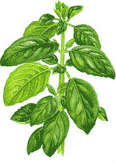The Case for Medicinal Herbs
 I've long been an admirer of medicinal herbs. They work. Period. The below content is a speech I wrote for a graduate school project. I felt is had some "giddy-up" to it so I thought I would submit it here.
I've long been an admirer of medicinal herbs. They work. Period. The below content is a speech I wrote for a graduate school project. I felt is had some "giddy-up" to it so I thought I would submit it here.
In the summer of 2003, then Los Angeles Lakers basketball coach Rudy Tomjanovich was diagnosed with bladder cancer. He was stunned,
shocked and was quoted as saying, “The fear that hits you when you hear the ‘C-word’ ... That negative mentality is just no good.” He instituted a
radical diet of all raw vegetables and over the next two months lost 30 pounds and that fall in October was pronounced cancer free. Think of it:
this man beat one of the most feared diseases that has mystified 21st century man – by eating a diet of raw vegetables alone.
Not chemotherapy, not surgery, not radiation – plain, run-of-the-mill vegetables.
The truth is Tomjanovich’s story is not unique. There are tens of thousands of people around the world who have cured themselves of supposedly incurable diseases by nature’s bounty – vegetables and medicinal herbs. “Why haven’t we heard of this before?” You may ask.
Good question.
Let’s explore that now. Western medicine is a great blessing to mankind, it clearly doesn’t have all the answers. It excels at clinical research, diagnosis, and emergency medical care but it utterly fails at the one thing it is supposedly meant to do – actually curing people of disease. In a study reported in the New England Journal of Medicine, an estimated one million patients nationwide are injured yearly by errors during hospital treatment and 120,000 people die as a result.
Also, pharmaceutical drugs have notorious side effects and are increasingly expensive. In a study published in the Journal of the American Medical Association, it was discovered that an estimated 100,000 Americans die annually as a result of correctly – yes correctly – prescribed medications. Did you also know that over two million patients experience adverse drug reactions in hospitals in the United States every year?
Of those, over 100,000 die making hospital-induced adverse drug reactions the fourth leading cause of death in America after heart disease, cancer and stroke. Think of it, the side effects that accompany virtually all pharmaceutical drugs are considered customary even normal!
That is an abominable attitude but one that is the norm with pharmaceutical companies. Let me give you an example of what I mean. According to one researcher, the following list comprises the reported side effects of the most popular cholesterol-lowering drugs on the market.
They are: dark yellow or brown urine, decreased urination, difficulty passing urine, fever, muscle pain, tenderness, cramps, weakness, redness, blistering, p eeling or loosening of the skin, including inside the mouth. It doesn’t end there.
eeling or loosening of the skin, including inside the mouth. It doesn’t end there.
They also include: skin rash, itching, unusual tiredness or weakness, yellowing of the skin or eyes, diarrhea, flatulence, headaches, joint pain, nausea, vomiting, stomach pain and upset.
Part of the problem is the enormous profitability pharmaceutical drugs give their manufacturers. Indeed, profit has superseded actually helping people. Plavix is now banned but not before it made a minimum of $6 billion per year from 2003 to 2008. Another drug Celebrex made a more modest $2 billion per year for its company from 2003 to 2008 before it was banned in 2009.
What about health care spending in America? What’s the status of that? Indeed, government spending on health care entitlement programs is gargantuan. Currently, the Medicare budget for fiscal year 2011 is $464.5 billion dollars while Medicaid spending will exceed $350 billion.
Together, Medicare and Medicaid represent 21% of the FY 2011 U.S. federal budget. According to the New York Times, the health care tab for 2010 was an astronomical $2.5 trillion! Health care spending now represents 17.3 percent of the nation’s gross domestic product — a 1.1 percent bigger portion of the nation’s economy than in 2008. Perhaps the most self-evident failure of the current system is the vaunted “War on Cancer.”
In 1971, then President Nixon declared the War on Cancer. According to an article published in Newsweek in 2008, “The federal government, private foundations and companies have spent roughly $200 billion on the quest for cures.” So, after so much money has been spent, are we any closer to a cure? The answer is a resounding no. Why? Is it because a lack of resources? There are $200 billion reasons I can think of that refute that belief.
The answer is simple: The Western medical establishment learned long ago that there is enormous – massive, prodigious – profits to be derived in health care. They learned the truth of the poker axiom that says, “You can shear a sheep many times but you can only shear it once.” As well-known comedian Bill Maher says, “The money is not made by keeping people healthy, it’s made by keeping them sick.”
Yes, indeed, The War on Cancer was a war that was never meant to be won – it was a war that was meant to be sustained. Why? Because the longer it lasts, the more money is made. You may be sitting there thinking that America has the best health care system in the world but do we? Do we really? According to the World Health Organization, America is the third most obese country in the world. Reuters says that “The United States spends more on health care than any country in the world but has higher rates of infant mortality, diabetes, and other ills than many other developed countries.” Plus, our life expectancy is only fifth highest in the world. Think of it: the one country in the world that spends more money per capita on health care has infant mortality rates that exceed many thirdworld African countries!
Clearly, throwing money at the problem is not the solution. So, is there a solution that is both cost effective – inexpensive even – and actually cures people of disease? There is – herbal medicine. “Herbal medicine?” you may ask. Yes, herbal medicine. Many listening to this presentation may scoff at herbal medicine’s efficacy. While Western medicine has certainly enriched mankind, it’s also profited beyond the dreams of even the most corrupt Roman emperor or aristocratic land baron. In truth, it’s the U.S. that is behind when it comes to adopting herbal medicine. In Germany, certain herbs are commonly prescribed for various health ailments. In Australia 57 percent of the population prefers herbal medicine to Western medicine. In the Philippines, their Department of Health has endorsed ten medicinal herbs for prescription usage.
In China, medicinal herbs have been the preferred method of holistic healing for over 3,000 years. In Japan and Korea, the usage of medicinal herbs is also commonplace. So, too, in India and Russia. Earlier we talked about cholesterol-lowering drugs. One of these drugs sells for anywhere from $120 to $190 per bottle.
 Did you know you can get the same cholesterol-lowering effect without side effects while also accruing a whole host of other therapeutic benefits from a simple, commonly used spice? You can. This spice, cayenne pepper, has been proven in a clinical study in Korea to lower the bad LDL cholesterol in the blood while also removing built-up plaque on arterial walls, thus reducing the number-one risk factor in heart disease.
Did you know you can get the same cholesterol-lowering effect without side effects while also accruing a whole host of other therapeutic benefits from a simple, commonly used spice? You can. This spice, cayenne pepper, has been proven in a clinical study in Korea to lower the bad LDL cholesterol in the blood while also removing built-up plaque on arterial walls, thus reducing the number-one risk factor in heart disease.
Moreover, in studies done by Keio University in Japan, U.C.L.A. in America, and the University of Nottingham in England, cayenne’s active ingredient capsaicin – the ingredient that makes it hot to the taste – has been found to kill breast, prostate, pancreatic, and leukemic cancer cells in a process known as “apoptosis.” This process of apoptosis causes the cancerous cells to self-terminate while leaving healthy cells around them unaffected.
As I close, I hope you’ll now see that there is another option available. By combining the best of traditional Western medicine with herbal medicine, health care costs could be astonishingly and dramatically, reduced while the health of Americans radically improved.
German philosopher Arthur Schopenhaeur was right when he said, “All truth passes through three stages. First, it is ridiculed. Second, it is violently opposed. Third, it is accepted as being self-evident.” Undoubtedly, the U.S. government and the entrenched and ever-profitable health insurance companies and the medicalestablishment will resist such chan
ges for it would mean the literal loss of billions and billions of dollars in profits and tax revenue. It will ridicule and violently oppose such change, which resistance until now has been quietly behind the scenes preventing and limiting master herbalists from practicing their art. But now, a new paradigm shift has begun.
Never before has the public been more distrustful of the American medical establishment, and rightly so. Never before has the public been more open to alternatives. At the end of the day, it’s not what people say that counts, it’s not even what they do that matters either – it’s the results that are produced. Can anyone in this audience tonight legitimately say that our health care system is a resounding success? Can you? It’s time for a change. The answer to America’s health care crisis is medicinal herbs.
--------------------
Editor's note: If you're looking for more information on cayenne, bee pollen, and the best multivitamins, I've provided some links for you. They are powerful. Learn more about bee pollen here: beepollensecrets.com/. You can learn more about pharmaceutical grade quality vitamins here: https://www.nutritional-supplement-bible.com/the-best-multivitamins.html. If you're interested in colon cleansing, this site here is good: https://www.bestcoloncleansesecrets.com/. Here's the site link for cayenne's heatlh benefits: https://www.cayennepepper.info/health-benefits-of-cayenne-pepper.html. The author of this article is also the webmaster of the following dental site, written with the help of a dentist friend, https://dentalnightguardinfo.com/. For a good site on clinical research, check out PubMed.gov.
....
Tags:
—————
